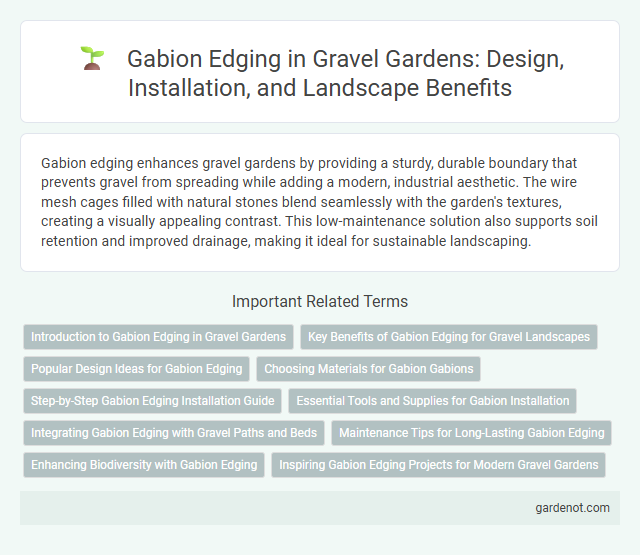Gabion edging enhances gravel gardens by providing a sturdy, durable boundary that prevents gravel from spreading while adding a modern, industrial aesthetic. The wire mesh cages filled with natural stones blend seamlessly with the garden's textures, creating a visually appealing contrast. This low-maintenance solution also supports soil retention and improved drainage, making it ideal for sustainable landscaping.
Introduction to Gabion Edging in Gravel Gardens
Gabion edging in gravel gardens combines steel wire cages filled with natural stones to create durable, eco-friendly borders that prevent gravel displacement. This versatile method enhances garden structure while promoting drainage and weed control, making it ideal for sustainable landscaping. Gabion edging also offers customization in height and shape, allowing seamless integration with various garden designs.
Key Benefits of Gabion Edging for Gravel Landscapes
Gabion edging provides exceptional stability and durability for gravel landscapes by securely containing gravel and preventing erosion or spreading. Its permeable design promotes effective drainage, reducing water buildup and soil erosion around garden beds. The natural stone appearance of gabion edging enhances aesthetic appeal while offering low maintenance and long-lasting structural support.
Popular Design Ideas for Gabion Edging
Gabion edging creates a striking contrast in gravel gardens by combining natural stone-filled wire cages with the soft texture of gravel. Popular design ideas include using gabions as raised borders, garden benches, or retaining walls to add structure and functionality. Incorporating varying stone sizes and colors inside the gabions enhances visual interest and complements the overall landscape design.
Choosing Materials for Gabion Gabions
Selecting durable, weather-resistant materials such as galvanized steel or PVC-coated wire mesh ensures long-lasting gabion edging for gravel gardens. Incorporating natural stone or recycled concrete as infill enhances both structural stability and aesthetic appeal. Proper material choice prevents corrosion and maintains the integrity of gabion structures in varying outdoor conditions.
Step-by-Step Gabion Edging Installation Guide
Gabion edging installation begins with selecting durable wire mesh baskets filled with natural stones for a strong, weather-resistant boundary around gravel gardens. Start by measuring and marking the area, then level the ground before placing the empty gabion baskets; once positioned, fill them with uniformly sized stones to ensure stability and aesthetic appeal. Finally, securely close the baskets and compact the surrounding gravel to create a clean, defined edge that enhances drainage and prevents gravel displacement.
Essential Tools and Supplies for Gabion Installation
Essential tools for gabion edging installation include wire cutters, pliers, and a mallet to securely shape and connect gabion baskets. Durable galvanized steel mesh gabion cages, high-quality galvanized wire, and appropriate gravel or stone fill are vital supplies for a stable and long-lasting gravel garden edge. Proper measuring tape and level ensure precise alignment and consistent height throughout the gabion edging project.
Integrating Gabion Edging with Gravel Paths and Beds
Gabion edging offers a durable and visually striking way to define gravel paths and beds, enhancing garden structure while preventing gravel displacement. The wire mesh cages filled with stones create a natural barrier that blends seamlessly with the gravel, promoting drainage and reducing soil erosion. Integrating gabion edging into gravel gardens improves overall landscape stability and adds a contemporary architectural element to outdoor spaces.
Maintenance Tips for Long-Lasting Gabion Edging
Gabion edging requires periodic inspection to ensure wire mesh remains intact and corrosion-free, especially in wet or coastal environments where rust can accelerate. Clearing debris and vegetation from the gabion structure prevents displacement and supports proper drainage, preserving the stability of the gravel garden. Applying a protective zinc coating or using stainless steel mesh can significantly extend the lifespan and maintain the structural integrity of gabion edging.
Enhancing Biodiversity with Gabion Edging
Gabion edging in gravel gardens creates natural habitats by providing shelter and nesting sites for beneficial insects, small birds, and amphibians. The porous structure supports diverse plant growth by retaining moisture and offering microclimates conducive to native flora. Integrating gabion edging boosts local biodiversity while maintaining the garden's aesthetic appeal and functional boundary.
Inspiring Gabion Edging Projects for Modern Gravel Gardens
Gabion edging offers a sleek, durable solution for defining pathways and flower beds in modern gravel gardens, combining natural stone with metal frames for a striking contrast. Innovative projects showcase gabions filled with varying rock sizes and colors, creating textured boundaries that enhance the garden's minimalist aesthetic. Their low-maintenance design ensures longevity while adding structural interest and eco-friendly drainage benefits to contemporary garden layouts.
Gabion edging Infographic

 gardenot.com
gardenot.com